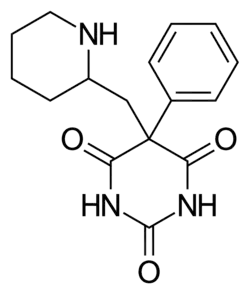Prazitone
 | |
| Clinical data | |
|---|---|
| Other names | AGN-511; 5-Phenyl-5-(2-piperidylmethyl)barbituric acid |
| ATC code |
|
| Identifiers | |
| |
| CAS Number | |
| PubChem CID | |
| ChemSpider | |
| UNII | |
| CompTox Dashboard (EPA) | |
| Chemical and physical data | |
| Formula | C16H19N3O3 |
| Molar mass | 301.346 g·mol−1 |
| 3D model (JSmol) | |
| |
| |
| | |
Prazitone (INN, BAN; developmental code name AGN-511) is a barbiturate derivative described as an antidepressant which was developed in the 1960s.[1][2] Unlike most barbiturates, it has little or no sedative effects, instead acting as a non-sedating anxiolytic and antidepressant.[3][1] The dosage range in humans is around 200–600 mg, although higher doses have been used in trials for the treatment of depression associated with Parkinson's disease.
References
- ^ a b Elks J (2014). The Dictionary of Drugs: Chemical Data: Chemical Data, Structures and Bibliographies. Springer US. p. 1011. ISBN 978-1-4757-2085-3. Retrieved 20 October 2024.
- ^ DE 1645911, Wiggins LF, Gittos MW, James JW, "Process for the preparation of derivatives of barbituric acid", issued 30 May 1973, assigned to Aspro Nicholas Ltd.
- ^ US 3806596, Langlands R, "Method for imparting anti-depressant and/or anxiolytic effects to animals.", issued 23 March 1974, assigned to Aspro Nicholas Ltd.